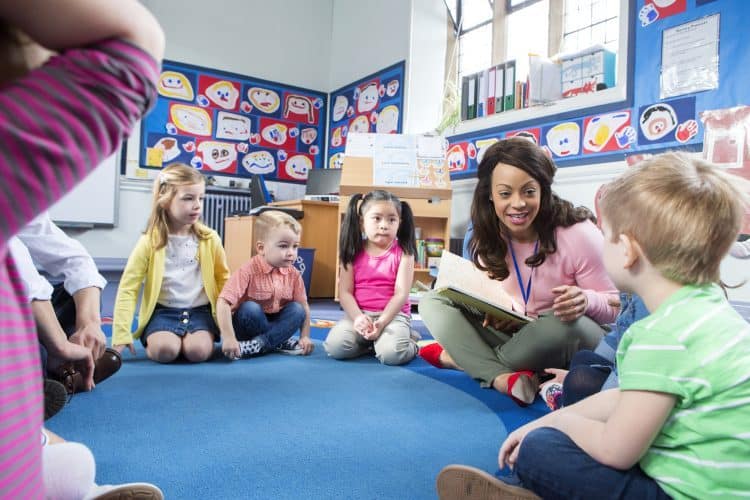Dyslexia is a language processing disorder that affects phonological and phonemic awareness, spelling, and word recognition. Around 90% of all reading difficulties are rooted in dyslexia, which affects approximately one in five students.[11] Because you’ll probably have at least a few children with dyslexia in your class every year, it’s essential to learn how to best reach these students.
Read on to find 15 fun and useful activities, learning strategies, and activities for students with dyslexia. Then, learn a few facts and myths about dyslexia to understand more about students with this chronic reading disorder.
Guided Reading Activities for Children with Dyslexia
 Activities are a great way to make reading fun while reaching students with dyslexia who may need added academic support. Check out these five activities for struggling readers to engage your students while addressing common dyslexia symptoms. Although these activities are designed to be educational games for dyslexia, you can play them one-on-one or as a class.
Activities are a great way to make reading fun while reaching students with dyslexia who may need added academic support. Check out these five activities for struggling readers to engage your students while addressing common dyslexia symptoms. Although these activities are designed to be educational games for dyslexia, you can play them one-on-one or as a class.
1. Letter Art
Students with dyslexia often benefit from visual aides while learning to read and recognize letters. Assign a letter for your students to paint or draw–maybe a letter they’ve had trouble writing or one they often mistake for a different letter. Encourage them to make it as colorful and creative as they want. Once they’ve finished, have them share their art with the class.
For older students who already have their letters down, try having them paint vocabulary words or drawing illustrations to go through commonly mistaken words.
2. Storytime Rhymes [3]
Rhyming is one of the best phonological awareness activities because it helps students with dyslexia learn letter-sound connections. Try reading a picture book with plenty of rhymes to your students. After each rhyming pair, brainstorm other words that rhyme to encourage students to practice phonological awareness on their own.
Here are a few examples of fun rhyming books you can read during this activity:
- Sheep in a Jeep by Nancy Shaw
- Brown Bear, Brown Bear, What Do You See? By Eric Carle and Bill Martin, Jr.
- Where the Sidewalk Ends by Shel Silverstein
- Llama Llama Red Pajama by Anna Dewdney
- One Fish, Two Fish, Red Fish, Blue Fish by Dr. Seuss
3. Building Words with Magnets [9]
Many students with dyslexia benefit from tactile activities so they can rely on more than just words on a page while learning to read. Hand out alphabet magnets as well as a magnetic board to your students and have them build simple words with the magnets to give them a visual and tactile reference for different letters.
4. Phonemic Awareness Name Game [1]
Another common symptom of dyslexia is issues with phonemic awareness, or the ability to identify specific sounds in words. For this activity, have your students gather in a circle. Choose a student’s name and sound it out one syllable at a time while clapping in-between syllables. Then, have the class repeat the student’s name together in the same way.
Go around and repeat this activity with every child’s name in your class. Once your students get the hang of it, try playing this game with vocabulary words.
5. Online Reading Activities
There are a variety of online reading games that are made for students with dyslexia or early learners in general. Plan computer lab sessions with your students to play online reading games and strengthen literacy skills in a non-stressful environment. Some reading programs can even adapt to focus on a student’s academic weaknesses, which can help students with dyslexia practice skills that they need to improve the most.
Classroom Accommodations for Dyslexia
 Finding the right accommodations for students with disabilities can help them catch up to their peers and reach their academic potential. Try these five accommodations for students with dyslexia to give every child in your classroom the tools they need to succeed.8
Finding the right accommodations for students with disabilities can help them catch up to their peers and reach their academic potential. Try these five accommodations for students with dyslexia to give every child in your classroom the tools they need to succeed.8
6. Audiobooks
Because children with dyslexia are often slow readers, assigning them print books on their own can frustrate them. Instead, try providing audiobook files alongside a take-home print book. That way, your student can read along with the narrator without getting caught on challenging words or letters.
7. Voice Recorder [2]
Similarly, it can take more time for a student with dyslexia to copy down notes than it would for their peers. Recording devices or apps can let your students record lessons in case they’re unable to copy down everything they need to remember in class.
8. Scribe or Speech-to-Text Software
For students with severe dyslexia symptoms, assigning a teacher’s aide to write down their notes can help keep the lesson on track and prevent your student from feeling overwhelmed. Speech-to-text software can also be useful for older elementary school students, who can use it for drafting typed assignments.
If you’re unable to offer either of these accommodations to your students, you could also provide copies of your lesson notes beforehand or write down the key points on the board.[2]
9. Spell-checker or Dictionary
Since children with dyslexia often mix up words or letters, discovering how to help a child with dyslexia spell can be tricky. A spell-checker can help your student correct simple mistakes that they might not notice at a first glance. As a non-electronic alternative, dictionaries can give students a reference for challenging or similar-looking words.
10. Quiet Time
Sometimes, too much outside stimulation can make it hard for students with learning disabilities to focus. If your student with dyslexia is having trouble with an assignment, ask them if they’d like to go to the library or a quiet corner of the room to work. Cutting out external stimulation can help their dyslexia symptoms feel less overpowering.
Effective Literacy Strategies for Students with Dyslexia
 Teaching strategies for dyslexia are designed to help students learn to read in a way that aligns with how their brain works. If your student with dyslexia is having a hard time learning literacy skills, use these four guided reading strategies and dyslexia exercises to help them turn their weaknesses into strengths.12.
Teaching strategies for dyslexia are designed to help students learn to read in a way that aligns with how their brain works. If your student with dyslexia is having a hard time learning literacy skills, use these four guided reading strategies and dyslexia exercises to help them turn their weaknesses into strengths.12.
11. Use Letter/Sound Flash Cards
Teaching students with dyslexia the relationship between print letters and sounds can help them grasp complex reading skills later on.[3] Flashcards are a particularly effective way to teach children with learning disabilities phonics and sight words, according to a study published in 2011.
Purchase a pack of index cards and write an alphabet letter on one side and the sound it makes on the other. Go through each card with your student, setting aside the ones they get wrong to practice later. With practice and repetition, children with dyslexia will begin to see a pattern between print letters and their specific sounds.
12. Try Multisensory Reading Techniques
Multisensory learning is one of the best strategies for dyslexia that educational researchers have discovered so far.[9] This means that while teaching a student with dyslexia to read, it can be helpful to engage their other senses. You could, for example, teach your students the alphabet song or give them letter-shaped graham crackers for a snack. Any activity that engages their auditory, tactile, visual, or even taste-based senses can make a big difference.
13. Simplify Written Instructions [2]
Although students with dyslexia are often smart enough to understand verbal directions, sometimes complicated written instructions can confuse them. Try to simplify the directions you write on an assignment as much as possible to make them accessible for all students in your class. If a student with dyslexia still has trouble understanding an assignment, try to talk them through anything that confuses them.
14. Give Students with Reading Disabilities Extra Time for Assignments [2]
Even if students with dyslexia work very hard on an assignment, they might have trouble finishing it on time. For reading or writing assignments, offer students with dyslexia extra time if they need it. That way, your student won’t feel rushed and can turn in the best assignment that they can once they’ve finished it.
15. Maintain Daily or Weekly Routines [9]
Students with dyslexia work best if they know what to expect in their assignments. Try to keep children with dyslexia on a regular schedule with similar projects every day or week. You could, for example, give your students time to read quietly every day or have weekly vocabulary assignments to establish a routine.
Dyslexia Facts vs Dyslexia Myths: Teacher Edition
 When it comes to learning disabilities in children, there is no such thing as “typical.”[12] Every student with reading disabilities is different and has their own strengths and weaknesses beyond common dyslexia stereotypes. Discover the truth behind these popular dyslexia myths to understand more about this well-known, yet misunderstood reading disorder.
When it comes to learning disabilities in children, there is no such thing as “typical.”[12] Every student with reading disabilities is different and has their own strengths and weaknesses beyond common dyslexia stereotypes. Discover the truth behind these popular dyslexia myths to understand more about this well-known, yet misunderstood reading disorder.
“Dyslexia is caused by poor eyesight.”
A 2011 survey found that the majority of PreK teachers believe that dyslexia is a visual processing disorder.[13] But this reading disorder doesn’t have to do with vision problems at all: dyslexia is a language processing disorder that originates in the brain, not the eyes. Even students with 20/20 eyesight can develop dyslexia.
“Boys are more likely to have dyslexia than girls.”
When teachers research how to help and spot dyslexia symptoms, their female students are often overlooked. But while educators often believe more boys are diagnosed with dyslexia than girls, they are mistaken. According to a study by the American Medical Association, dyslexia is equally common in both genders.[7]
“Dyslexia isn’t real. Students who have it are just lazy or ignorant.” [10]
While researchers haven’t pinpointed the exact cause of dyslexia yet, they now know that it is caused by genetic and neurological factors. These students usually work as hard or harder than their peers on their assignments, which can make their reading difficulties even more frustrating. Many students with dyslexia go undiagnosed for their entire life, and educators sometimes think their students are just reluctant readers when they have a legitimate learning disorder.[11]
“Given time, dyslexia can be fully cured.”
Dyslexia is chronic, which means that it doesn’t always go away with treatment. But while certain symptoms may stay with a student for their whole lives, the right activities or learning strategies can teach them to read and write in a way that works best for their brain.
Plus, there are actually some cognitive benefits to having dyslexia. Educational researchers have discovered that students with dyslexia are highly creative thinkers and more likely to come up with innovative solutions to their assignments.[11] Students with dyslexia may think and learn differently from their classmates, but that doesn’t make their strengths any less valuable.
“Children with dyslexia can never hope to read well or succeed in school.”
When a child is diagnosed with dyslexia, some teachers believe that they will never learn to read as well as other students. But children with dyslexia can learn to read and write as well as anyone else, given time and plenty of instruction.
In fact, quite a few famous writers have been diagnosed with dyslexia, including:
- F. Scott Fitzgerald (The Great Gatsby)
- Agatha Christie (Murder on the Orient Express)
- Hans Christian Andersen (The Little Mermaid, Thumbelina, and The Snow Queen)
- Avi (The True Confessions of Charlotte Doyle)
- Lewis Carroll (Alice’s Adventures in Wonderland)
Another name you might recognize who makes the list of famous people with dyslexia? Albert Einstein, who many people believe to be the smartest person to ever live, was also diagnosed with this reading disability. No matter what a child with dyslexia decides to study in life, their only limits are their passion and their motivation to succeed.
Sources:
Adams. M.J., Foorman, B., Lundberg, I., and Beeler, T. Phonemic Activities for the Preschool or Elementary Classroom. Retrieved from readingrockets.org: http://www.readingrockets.org/article/phonemic-activities-preschool-or-elementary-classroom.[1]
International Dyslexia Association. Dyslexia in the Classroom: What Every Teacher Needs to Know. Retrieved from dyslexiaida.org: https://dyslexiaida.org/wp-content/uploads/2015/01/DITC-Handbook.pdf.[2]
The Understood Team. Dyslexia Symptoms in Children. Retrieved from understood.org: https://www.understood.org/en/learning-attention-issues/signs-symptoms/could-your-child-have/checklist-signs-of-dyslexia-at-different-ages.[3]
Learning Ally. Hidden in Plain Sight: Seven Common Signs of Dyslexia in the Classroom. Retrieved from learningally.org: https://www.learningally.org/Portals/6/Docs/white-papers/HiddeninPlainSight_WP_o.pdf [4]
Yale Center for Dyslexia & Creativity. Signs of Dyslexia. Retrieved from yale.edu: https://dyslexia.yale.edu/dyslexia/signs-of-dyslexia/.[5]
National Council for Special Education. Dyslexia and Reading Instruction. Retrieved from sess.ie: https://www.sess.ie/dyslexia-section/dyslexia-and-reading-instruction.[6]
Shaywitz, S.E., Shaywitz, B.A., and Fletcher, J.M. Prevalence of Reading Disability in Boys and Girls Results of the Connecticut Longitudinal Study. Journal of the American Medical Association, August 1990, 264(8), pp. 998-1002.[7]
International Dyslexia Association. IDA Dyslexia Handbook: What Every Family Should Know. Retrieved from readingrockets.org: http://www.readingrockets.org/sites/default/files/IDA%20Dyslexia%20Handbook.pdf.[8]
International Dyslexia Association. Multisensory Structured Language Teaching Fact Sheet. Retrieved from dyslexiaida.org: https://dyslexiaida.org/multisensory-structured-language-teaching-fact-sheet/.[9]
Gwernan-Jones, R., and Burden, R.L. Are they just lazy? Student teachers’ attitudes about dyslexia. Dyslexia: An International Journal of Research and Practice, February 2010, 16(1), pp. 66-86.[10]
Dyslexia Resource. Interesting Dyslexia Facts and Statistics. Retrieved from dyslexiaida.org: https://dyslexiaresource.org/information-about-dyslexia/dyslexia-facts/.[11]
Elliott, J.G. Dyslexia: Diagnoses, Debates, and Diatribes. Education Canada, 2010, 46(2), pp. 14-17.[12]
Howard-Jones, P.A. Neuroscience and education: myths and messages. Nature Reviews Neuroscience, October 2014, pp. 1-8.[13]
Erbey, R., McLaughlin, T.F., Derby, K.M., and Everson, M. The effects of using flashcards with reading racetrack to teach letter sounds, sight words, and math facts to elementary students with learning disabilities. International Electronic Journal of Elementary Education, July 2011, 3(3), pp. 213-26.[14]

